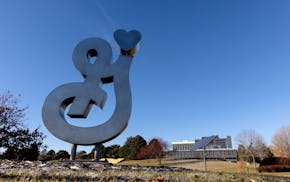Minnesota added 14,400 jobs in August, the largest monthly increase in jobs in more than two years.
In perhaps even better news, federal officials revised last month's employment figures for Minnesota. Rather than a loss of 1,100 jobs, as was reported for July, the state actually gained 2,500 payroll jobs from June to July.
Overall, Minnesota has now added jobs in nine of the last 12 months, state officials announced Thursday.
And state wage growth has handily outpaced inflation so far this year.
Furthermore, the state's labor force participation rate is among the best in the country, said Matt Varilek, commissioner of the Minnesota Department of Employment and Economic Development.
"This is a great month for Minnesota's jobs market," he told reporters during a virtual news conference. "We added the most jobs in a single month in two years, reflecting employers' ongoing appetite to hire more workers."
For August, employment grew by 0.5% in Minnesota, faster than the national rate.
Minnesota's unemployment rate increased slightly in August to 3.3%, but still remained lower than the national rate of 4.2%. The labor force participation rate remained flat at 67.7%, said officials from the Minnesota Department of Employment and Economic Development (DEED).
The state lost jobs in the construction, manufacturing and mining/logging sectors.
But eight of the state's 11 "super sectors" added jobs last month, led by strong growth in the leisure and hospitality industry, which gained 4,300 positions. The education and health services and professional and business services sectors grew by a respective 4,200 and 3,900 jobs.
So far, Minnesota has gained a net 41,695 jobs — or 1.4% — this year, slightly slower than the national rate of 1.5%.
Billy Schoenburg, president of Hell's Kitchen in downtown Minneapolis, said that even with the pinch of the temporary hires at the Minnesota State Fair, "we've noticed that our hiring efforts have been a lot easier" in August as more people are looking for work and willing to take part-time shifts.
Rehiring after the big drop from the pandemic, he said, was necessary as Minneapolis Convention Center and local sporting events picked up. But the quest was truly difficult.
Hell's Kitchen had 107 workers in August. A year earlier, it had around 65, Schoenburg said.
"For our market, specifically downtown, the convention center was booked fully this year. That helped a lot. Events are good," he said.
He said there still isn't enough back-to-office traffic to necessitate any additional hiring for him.
Results varied among other restaurants.
Summer delivered "really weird" results for the family owners of the eight Los Ocampo restaurants in the Twin Cities. Julian and Emma Ocampo said summer is usually busy, with extra staff hired to cover demand from graduation parties, food-truck events and more.
"But this year, business was really slow since May, down like 30%," Emma Ocampo said. "We had to cut hours," but kept overall staffing around 120.
Then suddenly, toward the end of August and into September, business went into overdrive, she said.
"We don't really know why, but have a few armchair theories," she said.
They noticed people were preparing for back-to-school, closing up cabins to return to the Twin Cities and energized by the abrupt shift in the political climate as Vice President Kamala Harris entered the race for president as the Democratic opponent of former President Donald Trump.
As if someone flipped a switch, more people were eating out or catering, she said.
"We were expecting business to be down during the State Fair, but instead we had the opposite," Julian Ocampo said. The change prompted Los Ocampo to restore work hours and even add some.
In addition to restaurant and hospitality hiring, economists are closely watching the retail sector and its holiday staffing trends.
Target and Best Buy recently announced they already started adding thousands of seasonal workers.
The state is watching the trade, transportation and utilities sector — which includes retail. It added 1,000 jobs in August, mostly retail, which was not the case earlier in the year. To date, Minnesota retailers' employment is still down 0.2% for the year.
Minnesota wages since the beginning of the year have grown twice as fast as inflation.
The average private sector hourly wage is $37.74 in Minnesota, an increase of 5.9% over the year. The Consumer Price Index (CPI) a common measure of inflation, rose 2.5% over that time.
"Over the last several months, we have seen strong wage growth in Minnesota," said Angelina Nguyen, DEED's labor market information director. "Wage growth has consistently outpaced inflation, which is a good thing as we work to attract and retain talented workers for our labor force."
Boston Scientific to cut jobs after discontinuing heart device

Congressional Dems including Omar ask judge to extend whistleblower case against UnitedHealth

Congressional budget bill could kill solar industry in Minnesota just as it was gaining momentum
Virtual reality has transformed design process for Eden Prairie-based Tennant

